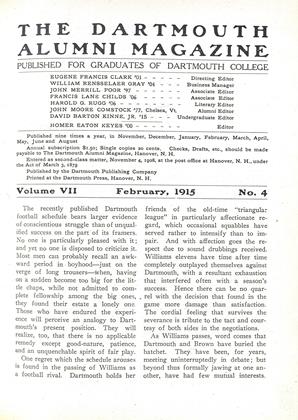This small book is neither an archaeological work, nor a many-sided guide to Asia Minor, but a chatty report, originally appearing in the form of letters to a newspaper, of visits made to the Seven Churches to which the Apostle John addressed his messages at the opening of the Book of Revelation.
Dr. Clark describes their present condition, from the busy mart of Smyrna, (second only in the Turkish Empire, in size and importance to Constantinople), to the site of Sardis, which city is now no more, or was no more, until Professor Howard Butler, of Princeton, began its excavation.
The author also renders another service especially to readers of the Apostle's message to the Churches of Ephesus, Smyrna, Pergamos, Thyatira, Sardis, Philadelphia, and Laodicea. With acknowledgments to Sir William Ramsay, he points out the topical and geographical allusions in the letters, which lent piquancy to them and drove home their points. The apostle did not hesitate to employ this means, more familiar to us .perhaps in politician's hands, to illustrate his message and associate it with the object or fact that was constantly before the inhabitants. Thus to the members of the church at Smyrna he writes of the 'crown of life,' for they had before them that wonderful 'crown of porticoes, and pictures and gold' that surmounted their citadel. When he penned the exhortation to the Christians of Sardis to 'be watchful,' they were reminded of the fall of their citadel which, regarded as impregnable, had been scaled by the Persian soldiers of Cyrus on its precipitous and unguarded side. Again the Apostle wrote to the Philadelphians 'I have set before thee an open door' and who better than they knew that their city was set at the entrance of the Hermus valley, the open door to the Far East? Similarly, to those who are fond of the sea, the Apostle's allusion to the time when there shall be 'no more sea' becomes intelligible when we realize his position as an exile on a small island, imprisoned by this element, and cut off from friends and churches just across the wav on the mainland, so near and yet so far.
Dr. Clark gives us the setting: of each oj the Seven Churches, its idiosyncracies, and claims that the messages sent them are as applicable- and just as much needed bv our churches today.
The trip, as he points out. should attract many. Smyrna is easily reached, which cannot always be said of Palestine and Cretan ports; and the journey on land is not formidable, in times of peace, for much of it can be accomplished by railway.
C. H. H.
Tim; the Autobiography of a Dog. Rt. Rev, Ethelbert Talbot, 1870. Harper's.
Tim is a pleasant story about a dog. Tim's master, Bishop Talbot, has allowed him to tell of his own life in his own way. It is a delightful way, not only to casual readers but to the anything but casual readers,—I mean jealous _ dog-owners who read all such tales with the firm conviction that only their particular Tims are the best and cleverest dogs alive.
Tim was a gentleman, and we put the book down feeling sure that we would like to have known him.
Herbert A. Miller '99 is the author of "Incomes of College Graduates Ten and Fifteen Years After Graduation," in Science for October 2, 1914.
Gordon Hall Gerould '99 contributes "Louvain About 1600" in the Nation for September 10, 1914.
Volume 1, Number 1, of the Bulletinof the Kimball Union Academy, to be published quarterly, has just appeared from the press. Harry Bovnton Preston '05 is editor-in-chief. This number contains an account of the dedication of the new gymnasium at Meriden which was given by Dr. Henry Mann Silver '72. At this dedication Professor E. J. Bartlett '72 gave an address, an abstract of which appears in the Bulletin.
"The One Hundred and Fiftieth Anniversarv of Lancaster, New Hampshire, 1764-1914", an attractive illustrated volume just issued, contains much of interest to Dartmouth men. This volume contains an address by Judge Albert R. Savage '71, an address by Ex-Governor S. D. Felker '82, and a synopsis of the play, "The Founders" by Fred W. Baker '03, a play with local setting written for the occasion of the celebration.
Among the addresses delivered at the fifth annual convention of the Southern Commercial Congress, held in Mobile, Ala., October 27-29, and published recently as Senate Document Number 440, of the second session, 63rd Congress, is an address by John Barrett '89.
The volume "Dedication of a Statue of General Franklin Pierce, Fourteenth President of the United States, at the State House, Concord, N. H., Nov. 25, 1914," contains addresses by Clarence E. Carr '75 and Ex-Governor Samuel D. Felker '82. The appendix in this volume contains, "Franklin Pierce, the Lawyer," an address delivered by the late David Cross '41 before the New Hampshire Bar Association in 1900.
"Early New England Schools", by the late Walter H. Small '78 will be reviewed in an early number of the MAGAZINE.
 View Full Issue
View Full Issue
More From This Issue
-
 Article
ArticleOXFORD IN WAR TIME
February 1915 By Conrad E. Snow '12 -
 Article
ArticleTHE AMERICAN ASSOCIATION OF UNIVERSITY PROFESSORS
February 1915 By Richard W. Husband -
 Article
ArticleGERMANY AT WAR
February 1915 By Max Mueller -
 Books
BooksThe Life of Thomas Brackett Reed
February 1915 By CHARLES R. LINGLEY -
 Class Notes
Class NotesLOCAL ASSOCIATIONS
February 1915 -
 Article
ArticleThe recently published Dartmouth
February 1915









